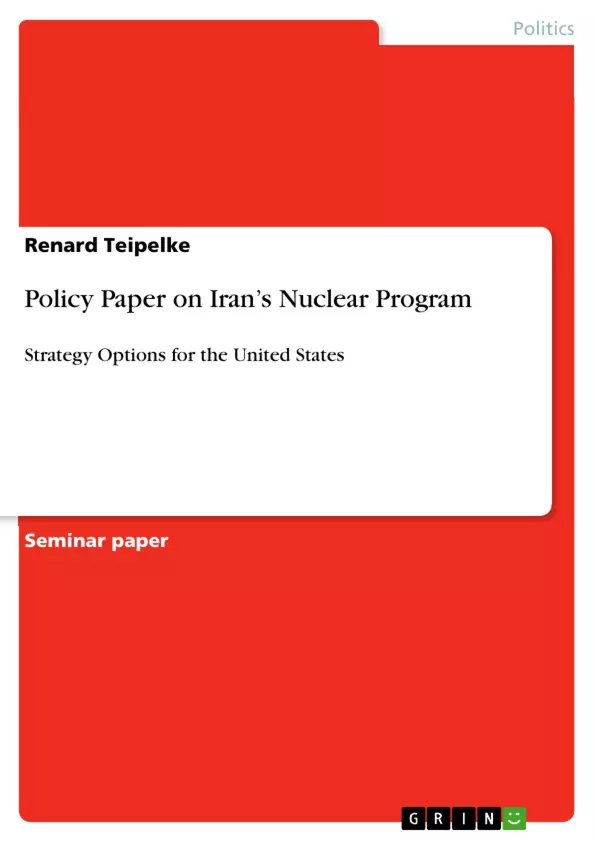The Iranian nuclear program has been one of the major controversies in international affairs in the 21st century. While Iran insists on the right to develop nuclear energy for peaceful purposes (under the terms of the Non-Proliferation Treaty, NPT), the international community fears the secret weaponization of Iran’s program. Neither could Iran convince the international community that it does not (intend to) work on a program for nuclear weapons, nor could the United States, the United Kingdom, France, Russia, China + Germany (P5+1 countries) – implement effective measures in the form of diplomacy with sanctions to initially deter Iran from pursuing nuclear weapons capability.
In the following policy paper, the problem will be first introduced by summarizing its history. A presentation of major players in the conflict and their preferences will help to analyze available strategy options for the United States as well as their possible consequences and chances of success. The following three strategies will be discussed...
Inhaltsverzeichnis (Table of Contents)
- Executive Summary
- Background of the Problem
- History
- Preferences of the Players
- Iran
- US & EU
- Russia & China
- Israel
- Arab States
- Options and Analysis
- Diplomacy with Sanctions
- Limited Preemptive Air Strike
- Massive Preemptive Strike with Regime Change
- Conclusions
Zielsetzung und Themenschwerpunkte (Objectives and Key Themes)
This policy paper examines the Iranian nuclear program and its implications for international security, focusing on the strategic options available to the United States. The analysis delves into the historical context, the preferences of key actors, and the potential consequences of various policy choices.- The history and development of Iran's nuclear program
- The roles and interests of key players, including Iran, the United States, the European Union, Russia, China, Israel, and Arab states
- The efficacy of diplomacy with sanctions in deterring Iran's nuclear ambitions
- The potential risks and benefits of military options, including limited and massive preemptive strikes
- The challenges and uncertainties associated with regime change in Iran
Zusammenfassung der Kapitel (Chapter Summaries)
The first section provides an overview of the Iranian nuclear program, highlighting its historical development and the ongoing controversy surrounding its peaceful or potentially weaponized intentions. The paper then presents the background of the problem, delving into the historical evolution of the program since the 1950s. This includes the role of the United States, European countries, and Russia in supporting or hindering Iran's nuclear ambitions. The chapter also examines the preferences of the key players involved, including Iran, the United States, the European Union, Russia, China, Israel, and Arab states. The third section focuses on analyzing various policy options for the United States, considering their potential effectiveness and consequences. It explores three primary strategies: diplomacy with sanctions, limited preemptive air strikes, and massive preemptive strikes with regime change. The paper discusses the strengths and weaknesses of each option, highlighting the challenges and potential outcomes associated with each approach.Schlüsselwörter (Keywords)
The core concepts of this policy paper revolve around the Iranian nuclear program, international security, diplomacy, sanctions, military intervention, regime change, and the preferences and actions of key players such as Iran, the United States, Russia, China, and Israel.- Arbeit zitieren
- Renard Teipelke (Autor:in), 2010, Policy Paper on Iran’s Nuclear Program, München, GRIN Verlag, https://www.grin.com/document/149679



